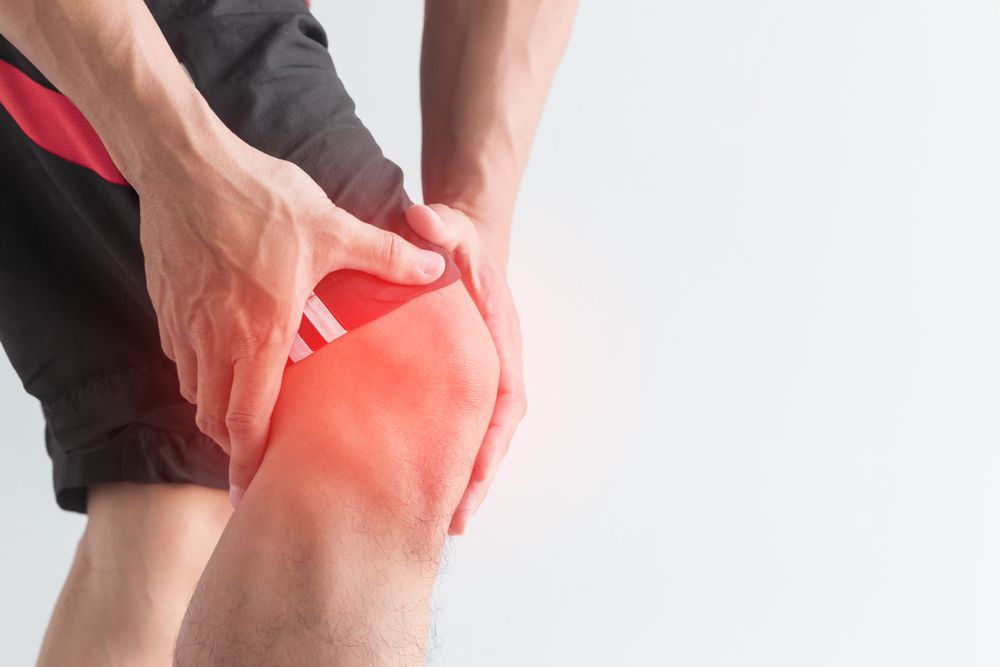
Your knees are important joints since they are critical to walking, lifting and sitting, but they are also extremely vulnerable to many health conditions. Whether you are a professional athlete, fitness enthusiast or sports fan, you have probably encountered a knee pain issue or know someone who has. If you have personally experienced knee pain, then you understand how excruciating this condition can be and why pain management is such a priority.
Knee pain is the second most common chronic pain condition in the U.S. (behind only back pain). Over one-third of all Americans will have a knee pain issue at some point in their lives. Between 15 and 20 percent of men will encounter knee pain, and almost 20 percent of women will have this issue.
A Closer Look at the Knee
The human knee is the largest and one of the most complex joints in the human body. Four bones, including one in the upper, two in the lower leg and the kneecap meet at the knee joint. Four major ligaments are also threaded through this joint including the
- Anterior Cruciate Ligament: prevents the tibia from moving too far forward.
- Posterior Cruciate Ligament: prevents the tibia from moving too far backward.
- Medial Collateral Ligament: stabilizes the inner part of the knee and helps prevent side-to-side movement of the femur.
- Lateral Collateral Ligament: stabilizes the outer part of the knee and helps prevent side-to-side movement of the femur.
There are also the medial and lateral menisci which cushion bone endings and allow free movement in the joint.
The knee has about 120 degrees of natural flexion, which is primarily limited by the presence of the patella or kneecap. The patella acts as a protective covering, preventing injury to the sensitive ligaments and menisci within the joint. The joint also allows a moderate amount of rotational motion around the axis of the lower leg.
Women tend to have more knee problems than men because their hips tend to be wider. This positions the femur at a more oblique angle that puts more stress on the knee. Furthermore, knee ligaments and thigh muscles are generally weaker in women, making them more prone to injuries like runner’s knee and ACL tears.
The human knee is also a major shock absorber during ambulation. Here are some of the forces placed on the knee of a 200 pound person during common activities:
- Walking 100 lbs
- Ascending stairs 660 lbs
- Descending stairs 1,000 lbs
- Jogging 1,400 lbs
As you can see, the stresses placed on the knee are quite large. Over a lifetime, this enormous strain can injure or weaken components of the knee.
Common Causes of Knee Pain
Knee pain may arise due to many factors. If you are experiencing knee pain, it is best to have a medical professional examine it since more than one of the following causes may be involved:
- Arthritis: joint pain accompanied by stiffness and inflammation may be a result of osteoarthritis, rheumatoid arthritis or dozens of other forms of arthritis. Without early medical intervention, your knee could be severely damaged, leading to limited mobility or disability.
- Cartilage tear: if you tear the medial or lateral menisci that protect the bones in the knee, you will likely experience pain and swelling. If the tear is minor, then it may heal in time. More serious meniscus tears may require surgery.
- Ligament tear: one of the most common and dreaded injuries in sports is a knee ligament tear, especially one involving the anterior cruciate ligament. Without surgery, a ligament tear will destabilize the knee raising the risk of a fall.
- Runner’s knee: despite the name, you don’t need to be a runner to acquire this condition. This pain is centered around the kneecap and may result from high stress exercises, a powerful collision, or a misalignment of bones. In most cases, symptoms resolve on their own if rested.
- Patellar dislocation: If your kneecap is misaligned, it can impede mobility, destabilize the knee joint, or produce pain and bruising. Although most kneecap dislocations can be treated with ice, rest and compression, more serious cases may require surgery.
Pain Management and Knee Pain Therapies
Knee pain is one of the most troubling health conditions because how much we use our legs. Luckily, there are many ways to treat knee pain. Before you engage in any of these pain management therapies, you should consult with your physician to avoid further injury.
- RICE: This is an acronym for Rest, Ice, Compression and Elevation. In the aftermath of a knee injury, remember to follow these suggestions, but only for a short period of time. Too much rest may weaken your muscles and make you more susceptible to injury. Ice only for 20 minutes at a time, then alternate with heat to promote circulation.
- Strength training: Many exercises like walking, swimming and cycling can ease knee pain by increasing your tolerance for pain and boost your body’s natural production of pain killers. Weight training and stretching that target leg muscles can lower the risk of future injury.
- Lose weight: You can dramatically reduce the strain on your knees by losing even a few pounds. A healthy diet and consistent fitness program can not only help eliminate some of that belly fat but will improve your sleep and your general sense of wellbeing.
- Get enough sleep: Many people with chronic pain issues suffer from poor sleep, but you shouldn’t be one of them. Poor sleep hinders your ability to heal and augments pain symptoms. Discuss with your doctor possible remedies for improved sleep.
- Walking aids: You may not want to look feeble, but if using a cane or walker limits your knee pain, you should consider using one. If it is effective for you, you may also want to try a knee brace or splint.
- Choose the right shoes: If you are unsure if the shoes you are right for your knee condition, you should consult with a podiatrist who may recommend custom shoes or orthotic inserts.
Article written by: Dr. Robert Moghim – CEO/Founder Colorado Pain Care
M.D. Disclaimer: The views expressed in this article are the personal views of Robert Moghim, M.D. and do not necessarily represent and are not intended to represent the views of the company or its employees. The information contained in this article does not constitute medical advice, nor does reading or accessing this information create a patient-provider relationship. Comments that you post will be shared with all visitors to this page. The comment feature is not governed by HIPAA and you should not post any of your private health information.



